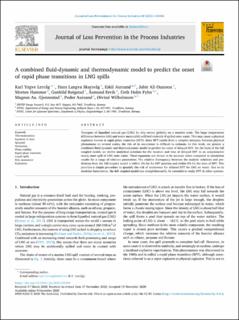| dc.contributor.author | Lervåg, Karl Yngve | |
| dc.contributor.author | Skarsvåg, Hans Langva | |
| dc.contributor.author | Aursand, Eskil | |
| dc.contributor.author | Ouassou, Jabir Ali | |
| dc.contributor.author | Hammer, Morten | |
| dc.contributor.author | Reigstad, Gunhild Allard | |
| dc.contributor.author | Ervik, Åsmund | |
| dc.contributor.author | Fyhn, Eirik Holm | |
| dc.contributor.author | Gjennestad, Magnus Aashammer | |
| dc.contributor.author | Aursand, Peder | |
| dc.contributor.author | Wilhelmsen, Øivind | |
| dc.date.accessioned | 2021-02-24T14:56:13Z | |
| dc.date.available | 2021-02-24T14:56:13Z | |
| dc.date.created | 2020-12-15T13:06:04Z | |
| dc.date.issued | 2020 | |
| dc.identifier.citation | Journal of Loss Prevention in the Process Industries. 2020, . | en_US |
| dc.identifier.issn | 0950-4230 | |
| dc.identifier.uri | https://hdl.handle.net/11250/2730194 | |
| dc.description.abstract | Transport of liquefied natural gas (LNG) by ship occurs globally on a massive scale. The large temperature difference between LNG and water means LNG will boil violently if spilled onto water. This may cause a physical explosion known as rapid phase transition (RPT). Since RPT results from a complex interplay between physical phenomena on several scales, the risk of its occurrence is difficult to estimate. In this work, we present a combined fluid-dynamic and thermodynamic model to predict the onset of delayed RPT. On the basis of the full coupled model, we derive analytical solutions for the location and time of delayed RPT in an axisymmetric steady-state spill of LNG onto water. These equations are shown to be accurate when compared to simulation results for a range of relevant parameters. The relative discrepancy between the analytic solutions and predictions from the full coupled model is within 8% for the RPT position and within 2% for the time of RPT. This provides a simple procedure to quantify the risk of occurrence for delayed RPT for LNG on water. Due to its modular formulation, the full coupled model can straightforwardly be extended to study RPT in other systems. © 2020 The Author(s) | en_US |
| dc.language.iso | eng | en_US |
| dc.publisher | Elsevier | en_US |
| dc.rights | Navngivelse 4.0 Internasjonal | * |
| dc.rights.uri | http://creativecommons.org/licenses/by/4.0/deed.no | * |
| dc.title | A combined fluid-dynamic and thermodynamic model to predict the onset of rapid phase transitions in LNG spills | en_US |
| dc.type | Peer reviewed | en_US |
| dc.type | Journal article | en_US |
| dc.description.version | publishedVersion | en_US |
| dc.source.pagenumber | 13 | en_US |
| dc.source.journal | Journal of Loss Prevention in the Process Industries | en_US |
| dc.identifier.doi | 10.1016/j.jlp.2020.104354 | |
| dc.identifier.cristin | 1860030 | |
| dc.relation.project | Norges forskningsråd: 244076 | en_US |
| dc.description.localcode | © 2020 The Author(s). Published by Elsevier Ltd. This is an open access article under the CC BY license (http://creativecommons.org/licenses/by/4.0/). | en_US |
| cristin.ispublished | true | |
| cristin.fulltext | original | |
| cristin.qualitycode | 1 | |

